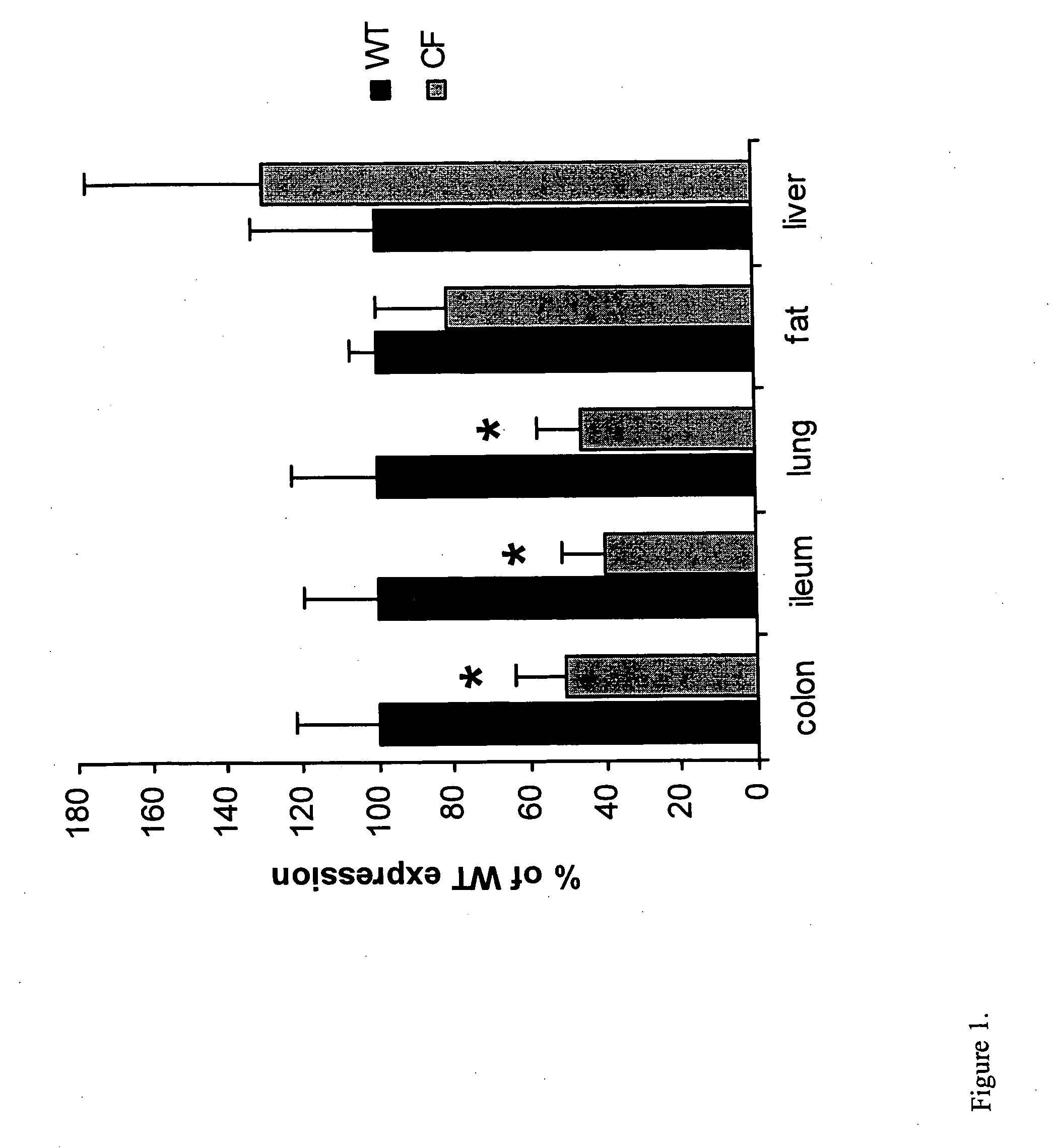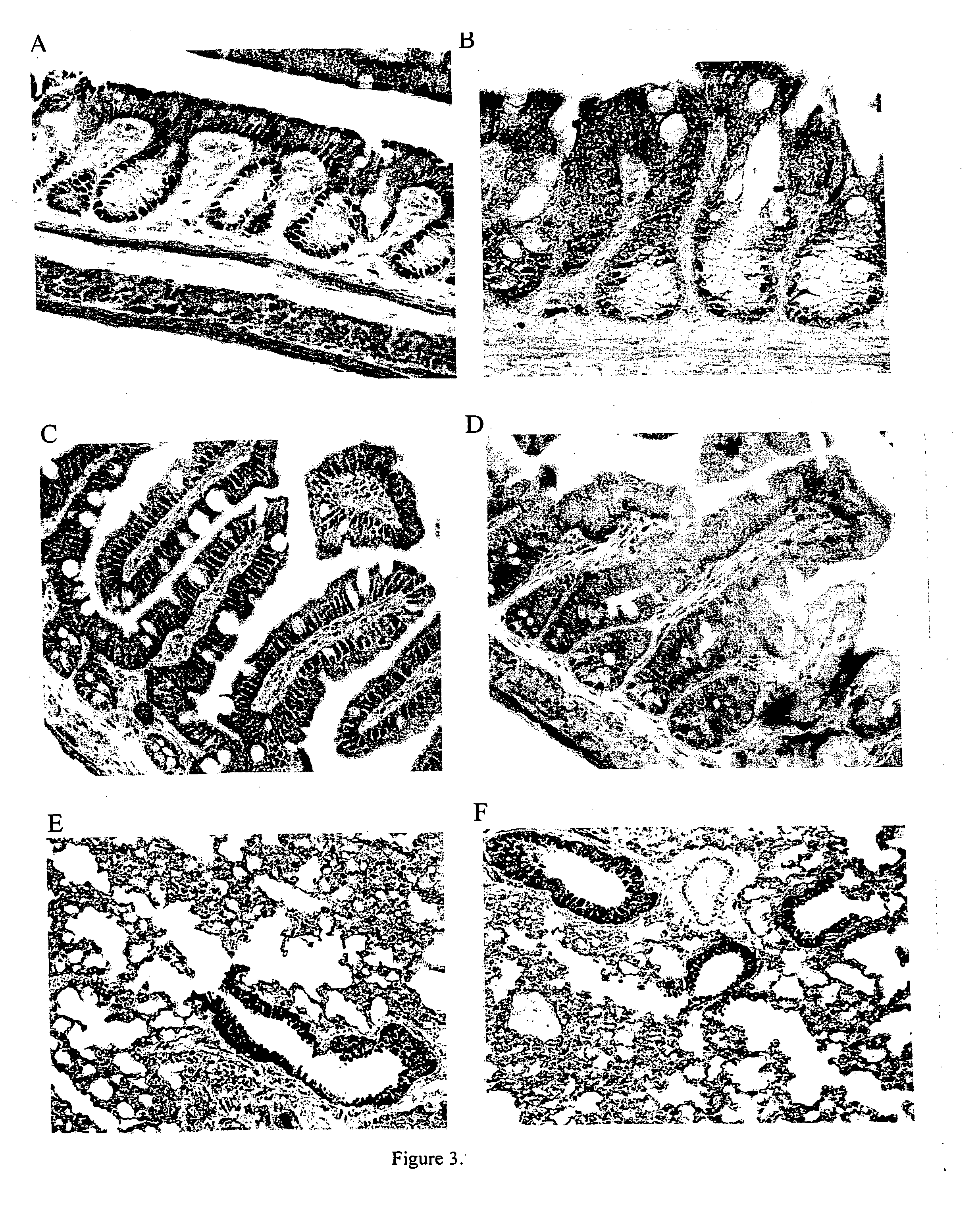Methods for modulating PPAR biological activity for the treatment of diseases caused by mutations in the CFTR gene
a technology of cftr and biological activity, which is applied in the direction of peptide/protein ingredients, biocide, heterocyclic compound active ingredients, etc., can solve the problems of chronic infections, thick sticky mucus layer that is not easily removed, and difficult to remov
- Summary
- Abstract
- Description
- Claims
- Application Information
AI Technical Summary
Problems solved by technology
Method used
Image
Examples
example 1
PPARγ Expression is Decreased in CFTR− / − Mice
[0065] An established breeding colony of exon 10 CFTR (cftr− / −) knockout mice and wild-type littermates was used for this study. Tail-clip samples of 14-day-old male mice were processed for genotype analysis. All mice were weaned at 23 days of age and then placed on Peptamen (Nestle Clinical Nutrition, Deerfield, Ill.) and water until 30 days of age, and then continued for 10 days with 15 mL / day of Peptamen. Mice were euthanized by CO2 and the organs harvested. Ileum and colon mucosal samples were prepared by opening up the intestine, removing the lumenal contents by flushing with PBS, and then scraping the mucosa from the muscle layers with a razor blade. Tissues were snap frozen in RNAlater (Ambion, Austin, Tex.) for RNA extraction (Barerett et al., Nat. Genetics 23: 32-33, 1999). For western blotting nuclear and cytoplasmic extracts were prepared as described below, and for immunohistochemistry tissues were fixed in 10% formalin.
[006...
example 2
Immunohistochemical Localization of PPARγ in CFTR− / − Mice
[0070] PPARγ immunostaining was performed using a rabbit polyclonal antibody (Cell Signaling, Beverly, Mass.). After pretreatment with 0.3% hydrogen peroxide in absolute methanol, sections were blocked with 1% BSA for 2 hours at room temperature and then incubated with the primary antibody (1: 100 dilution) overnight at 4° C. This was followed with washing and incubating with biotinylated secondary antibody (1:200 dilution). Peroxidase activity was visualized with 3,3′-diaminobenzidine (DAB kit; Vector Laboratories, Burlingame, Calif.) as a substrate. Omission of the primary antibody served as a negative control.
[0071] PPARγ was predominantly localized to nuclei in the mucosal layer of colon and ileum in wild-type mice, (FIGS. 3A and 3C). In contrast, the colon and ileum mucosa from cftr− / − mice showed reduced nuclear labeling and a predominant diffuse cytoplasmic staining (FIGS. 3B and 3D). Analysis of lung tissue showed a ...
example 3
Reduced PPARγ Levels in Colonic Epithelium Nuclei of CFTR− / − Mice
[0072] For western blotting of total, nuclear, and cytosolic extracts, tissue samples were harvested, minced, and homogenized in 0.5 ml of hypotonic buffer (20 mM Hepes pH 7.5, 5 mM NaF, 0.1 mM EDTA, 1 mM Na3VO4) containing 0.01% NP-40 with a pre-chilled Dounce homogenizer. The suspension was incubated 15 minutes on ice followed by centrifugation for 10 min at 850×g at 4° C. The supernatants (cytoplasmic fraction) were transferred and the pellets were resuspended in 0.5 ml hypotonic buffer containing 0.5% of NP-40, incubated 15 minutes at 4° C., centrifuged 30 sec at 14000×g and the supernatants discarded. Pellets, representing the nuclear fraction, were resuspended in 50 μl of lysis buffer (20 mM Hepes pH 7.5, 400 mM NaCl, 20% Glycerol, 0.1% EDTA, 10 mM NaF, 10 μM Na2MO4, 1 mM NaVO3, 10 mM PNPP, 10 mM β-glycerophosphate) containing 1 mM DTT and Complete Mini EDTA-free protease inhibitor cocktail (Roche Diagnostics, I...
PUM
| Property | Measurement | Unit |
|---|---|---|
| temperature | aaaaa | aaaaa |
| molecular weight | aaaaa | aaaaa |
| weight | aaaaa | aaaaa |
Abstract
Description
Claims
Application Information
 Login to View More
Login to View More - R&D
- Intellectual Property
- Life Sciences
- Materials
- Tech Scout
- Unparalleled Data Quality
- Higher Quality Content
- 60% Fewer Hallucinations
Browse by: Latest US Patents, China's latest patents, Technical Efficacy Thesaurus, Application Domain, Technology Topic, Popular Technical Reports.
© 2025 PatSnap. All rights reserved.Legal|Privacy policy|Modern Slavery Act Transparency Statement|Sitemap|About US| Contact US: help@patsnap.com



